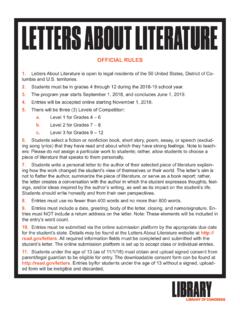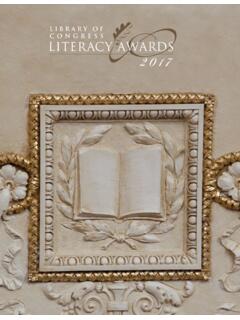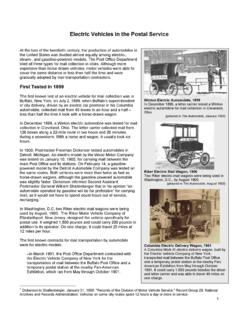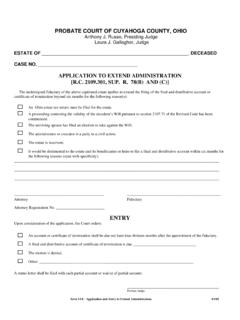Transcription of The Center for the Book in the Library of Congress …
1 The Center for the Book in the Library of Congress Letters About Literature Teaching Activities Part 1: Introduction You want me to write a letter ? Um .. What s a letter ? Harry picked it up and stared at it, his heart twanging like a giant elastic band. No one, ever, in his whole life had written to him. Who would? He had no friends, no other relatives he didn t belong to the Library , so he d never even got rude notes asking for books back. Yet here it was, a letter , addressed so plainly there could be no mistake: Mr. H. Potter The Cupboard under the Stairs 4 Privet Drive Little Whinging, Surrey Rowling, Harry Potter and the Sorcerer's Stone Although he did not know it then, the letter Harry Potter received that morning would change his life forever. What Harry did know is how the letter made him feel someone had thought about him and cared enough to write to him!
2 Letters have a way of giving special recognition to the person receiving it. And why is that? A letter is private, a great deal more private than posting a tweet or updating a status on social networks. It travels through space and time, becoming a bridge that can span decades, even centuries! A letter is not abstract or virtual. The reader can finger it and perhaps even sense the presence of the writer who penned the lines. When tied in bundles and saved in a drawer, letters can be history. Writing a letter takes time, not just to put the words into sentences, but to think about what to express and how to express it. Letters have attitude! They can be persuasive, argumentative or deviously clever, even downright funny. But they can also be diplomatic, encouraging, comforting. A letter demands thoughtfulness and patience, for the writer must select just the right words to convey his or her thoughts.
3 Most important, writing a letter requires an understanding of the person to whom you are writing. A letter is a personal, private relationship between the writer and the reader. Letters About Literature is a reading promotion program challenging students to express themselves through this very personal form of communication. The pages that follow are activities teachers can use to guide their students through the book discussion and letter -writing process. 2 Teacher OverviewResearch has shown that children gain greater understanding of what they have read when they are given frequent opportunities to respond to what they ve read, especially through writing. The writing response, in turn, helps to develop the students critical reading and thinking skills. And so the cycle goes children who read, write better; children who write, read more. This reading-writing link is the very heart of the Letters about Literature (LAL) program.
4 Many students may complain that writing a letter takes too long, that it is an obsolete form of communication. And in fact, a recent Pew Survey noted that among teens texting is now the preferred form of communication replacing Email and voice mail. ( Teens, Smartphones & Texting, March 19, 2012) letter writing does what these other forms of communication cannot allow the student to develop in detail his or her thoughts, to craft them with language that reflects their voices (rather than texting acronyms and symbols). letter writing allows students to practice a very important writing skill targeting a specific audience Readers enter LAL by writing a letter to an author living or dead explaining how that author s work somehow changed the reader s view of the world or self. The program has three competition levels: Level 1 for grades 4 - 6; Level 2 for grades 7 - 8; and Level 3 for grades 9 - 12vaThis teaching booklet has four lessons that take readers from prewriting discussions through writing and assessment.
5 They are: Lesson 1: Focus. Introduces readers to the concept that books can influence our perception of ourselves and our world. Lesson 2: Inquiry. Provides activities to help readers explore the unique relationship between themselves, an author, and a book. Lesson 3: Application. Provides writing tips to help readers shape informative, persuasive letters. Lesson 4: Assessment. Provides a checklist for editing and rewriting their letters for grammatical correctness and originality. Taken all together, these lessons and activities plus writing tips include: What did you learn about yourself either while reading or after reading this author s work? What elements within the book the author s characters or setting or style of writing, for example touched you emotionally or influenced your thoughts? What insights about the world did this book reveal to you? Write honestly and in your own voice, as if you were having a conversation with the author.
6 Those are the best letters to read and the most fun to write! Keep in mind these two tips: Correspond, don t compliment! Your letter should inform rather than flatter the author. All FAN letters will be eliminated! Do not summarize the book s plot! Because you are writing to the author, don t tell him or her what they already know what the book is about! Instead, use clear and relevant details to explain how the author s story affected you, what you learned and felt and understood that you didn t prior to reading the author s work. NATIONAL STANDARDS NCTE & IRA Standards Thousands of teachers have found LAL a valuable classroom project. Each year, the Center for the Book in the Library of Congress receives hundreds of letters from teachers testifying how the program s theme and guidelines dovetail with state standards for language arts. Listed below are the standards recommended by the National Council of It s funny; in this era of e-mail and voice mail and all those things that even I did not grow up with, a plain old paper letter takes on amazing intimacy.
7 Elizabeth Kostova, The Swan Thieves 3 Teachers of English and the International Reading Association that apply to the LAL program and recommended teaching activities included in this educational supplement. OBJECTIVES: Students will Apply a wide range of strategies to comprehend, interpret, evaluate and appreciate texts. Adjust their use of spoken, written and visual language for a variety of audiences and purposes. Employ a wide range of writing strategies. Apply knowledge of language structure, conventions. Participate as knowledgeable, reflective, creative and critical members of a variety of literacy communities. Use spoken, written and visual language to accomplish their purpose. COMMON CORE STATE STANDARDS (CCSS) A personal narrative describing change or an argument/opinion piece supporting a changed viewpoint of the world or self fits the goals of CCSS. Well-developed letters will have descriptive details and clearly stated links between personal experience and the text.
8 Effective argument/opinion writing will state a point of view and provide reasons and relevant and sufficient evidence to support the writer s stance. Grade Level Text Types & Purposes Production & Distribution of Writing 4 - Write opinion pieces on topics or texts, supporting a point of view with reasons and information. - Write narratives to develop real or imagined experiences or events using effective technique, descriptive details and clear event sequences. - Produce clear and coherent writing in which the development and organization are appropriate to task, purpose and audience. With guidance and support from peers and adults, develop and strengthen writing as needed by planning, revising and editing. 7 - Write arguments to support claims with clear reasons and relevant evidence. - Write narratives to develop real or imagined experiences or events using effective technique, relevant descriptive details and well-structured event sequences.
9 Same as above 11 Write arguments to support claims in an analysis of substantive topics or texts, using valid reasoning and relevant and sufficient evidence. - Write narratives to develop real or imagined experiences or events using effective technique, well-chosen details and well-structured event sequences. Same as above Note: The lessons and student worksheets begin on page 9 (Part 2). On pages 4 8 are the answers for each activity. 4 LESSON 1: FOCUS. Use this activity to introduce students to the Letters about Literature theme that books are more than entertainment; they are windows to understanding our society, other cultures and ourselves. MATERIALS Level I: Worksheet A Books Give Us Wings Level II: Worksheet B Books that Make You Think, Books that Make You Feel Level III: Worksheet C A letter from Lois Lowry PROCEDURE Warm up by asking students to list a book or books they remember reading as a very younger child, or a book they remember an adult reading to them.
10 List these on the chalkboard or overhead projector. Ask students to comment on the books. Which were funny? Which were scary? What feelings do they associate with the reading experience pride in being able to read the book? Affection from a parent or guardian who took time to read to them? Next, explore how their reading experiences have changed over time. For example, do they now read to a younger child? Do they prefer a different type of book than when they were younger? No doubt some children and young adults will complain that reading, while once fun, is no longer so. Explore why this may be the case. Distribute the reading worksheet identified for each level. Read, then discuss the questions. Answers will vary, but recommended answers are provided below. Conclude the activity by explaining the LAL assignment: Students will write a personal letter to an author living or dead explaining how that author s work somehow changed their view of the world or self.








